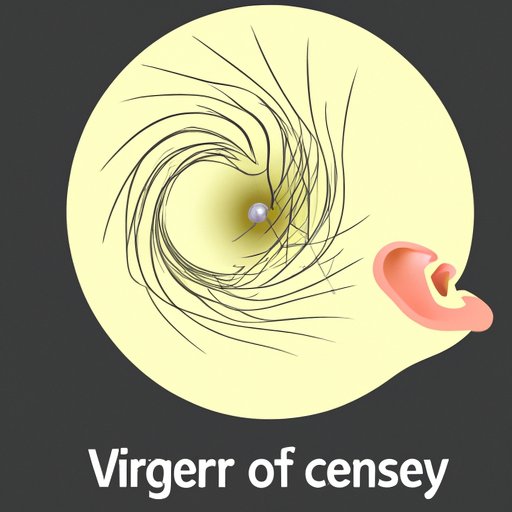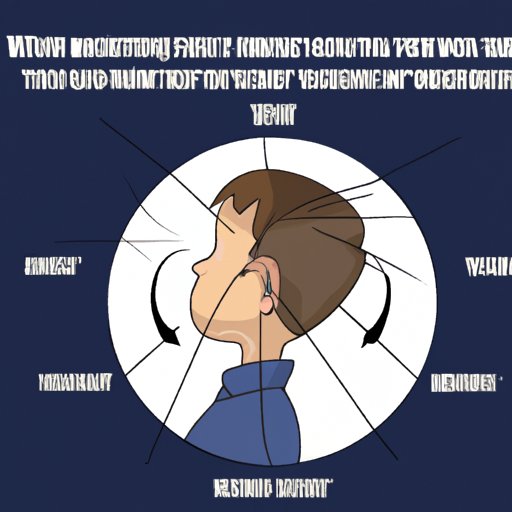
Introduction
Vertigo is a common condition that causes a sense of dizziness or spinning. It occurs when there is a disturbance in the balance system of the inner ear or the central nervous system. Identifying which ear is causing vertigo symptoms is essential for effective treatment. In this article, we will explore different tests and methods for determining the ear responsible for vertigo episodes.

How to Determine Which Ear is Causing Your Vertigo Symptoms
There are several tests and methods healthcare professionals use to determine which ear is causing vertigo symptoms. It’s important to note that these tests should be performed by a medical professional. It is not safe to attempt these tests at home without medical supervision, especially if you are experiencing frequent, severe, or persistent vertigo episodes.
5 Tests to Determine Which Ear is Causing Your Vertigo
The following are the tests or maneuvers that are commonly used to diagnose the ear responsible for vertigo:
Dix-Hallpike Maneuver
This maneuver is the most common test used to diagnose the cause of vertigo. It involves positioning the head in different angles while lying down to see if this brings on vertigo symptoms. A healthcare professional will observe your eye movements during the study to help identify the side causing the vertigo.
HINTS Exam
The “Head Impulse, Nystagmus, Test of Skew” exam is used to identify the cause of acute and persistent vertigo of central origin in patients with acute vestibular syndrome. In this exam, the healthcare professional will check for nystagmus (uncontrolled eye movements), observe the head impulse (brief and rapid movement of the head), and test for skew deviation (vertical misalignment of the eyes).
Head Impulse Test
The Head Impulse Test is another test to diagnose vertigo that may be caused by inner ear impairment. During this test, the healthcare professional will move the patient’s head quickly in different directions while looking for any abnormal eye movements.
Caloric Test
This test is done to check for asymmetrical function in the inner ear. It involves flushing cold or warm water into the ear to stimulate the balance system. The healthcare professional will observe any abnormal eye movements which can help diagnose the ear involved.
Rotary Chair Test
The rotary chair test is another test that evaluates the balance system of the inner ear. In this test, the patient will sit on a chair that rotates slowly while the professional will monitor eye movements to assess the balance of the inner ear nerves.
3 Simple Ways to Identify Which Ear is Causing Your Vertigo Episodes
Some simple ways to identify which ear is causing vertigo may include:
Paying attention to which ear feels affected
If you notice that vertigo is more pronounced on one side, it may be an indication that this is the ear causing the problem.
Noting the position in which vertigo symptoms occur
If a particular head position precipitates or worsens your vertigo, this may indicate that the affected ear is the one that experiences an abnormal response in that position.
Observing eye movements during vertigo episodes
During a vertigo attack, your eye movements may follow a specific pattern. Healthcare professionals use this pattern to diagnose which ear causes the vertigo.
A Step-by-Step Guide to Identifying the Ear Responsible for Your Vertigo
Here is a simple guide that outlines each of the tests or maneuvers to help you identify which ear is responsible for your vertigo:
Dix-Hallpike Maneuver
Lie down flat on the bed, ensuring that your head is at the edge of the bed and your legs are touching the floor. Turn your head 45 degrees to the side causing the vertigo. Then, quickly, but in a controlled manner, sit up straight so that your head hangs over the edge of the bed. Hold the position for about 30 seconds. If this maneuver brings on vertigo symptoms, it could indicate that the ear on the side you turned to is the affected ear.
HINTS Exam
This should be performed by a healthcare professional. The head impulse test and test of skew should be done first followed by nystagmus evaluation.
Head Impulse Test
Again performed by a healthcare professional, they will move your head rapidly, and you will be asked to fixate on a target in front of you. If an abnormal eye movement is detected, it could indicate an inner ear dysfunction.
Caloric Test
This maneuver should also be performed by a healthcare professional. You will lie down while cold and warm water is flushed into your ears one at a time- observing any abnormal eye movement can help for diagnosis.
Rotary Chair Test
You will sit in a chair that rotates slowly. You will then be asked to follow the sound of a beep while your eye movement is being reviewed by a device that monitors your eyes.
The Signs and Symptoms that will Help You Identify Which Ear is Causing Vertigo
There are several hallmark symptoms that a patient might experience depending on which part of the balance system is affected.
Inner Ear Symptoms
Inner ear diagnoses usually cause continuous and severe vertigo that may be accompanied by hearing loss, a feeling of fullness in the ear, and ringing in the ear (tinnitus). Others may experience imbalance or unsteadiness, especially while walking.
Central Nervous System Symptoms
Central nervous system (CNS) diagnoses generally cause milder or less severe vertigo that is fluctuating and can last from seconds to minutes. In addition to vertigo, those with CNS issues may have double vision, vision deficits, or difficulty speaking or swallowing, among other symptoms.
The Role of Hearing Tests in Identifying the Ear Responsible for Vertigo
In cases where hearing loss or tinnitus is present, audiologists can run tests to diagnose the most likely ear causing the symptoms. The audiologist can rule out hearing loss caused by dysfunction in the ear canal, middle ear space, and cochlea. If the symptoms point to nerve damage in the inner ear, the audiologist can then forward the results to an ear, nose, and throat specialist to interpret the findings and diagnose the cause of the vertigo.
How to Differentiate Between Inner Ear and Central Causes of Vertigo
The medical history and physical exam results can help differentiate between inner ear and central causes of vertigo.
Inner Ear Vestibular Dysfunction
If the patient has symptoms that are severe and long-lasting, developing rapidly, with hearing loss, and tinnitus, they are more likely to have inner-ear disorders. Examples may include Meniere’s Disease or Vestibular Neuritis.
Central Nervous System Disorders
If the vertigo is brief, short-lived, and occurs erratically, the cause may be more likely to involve the central nervous system. Examples may include a stroke, multiple sclerosis, or migraines.
Conclusion
Identifying the ear responsible for vertigo episodes is essential for effective management of the condition. The steps and tests outlined above can guide you in identifying the problem effectively. If you are unsure, or if your symptoms are severe, frequent, or persistent, it is always best to seek medical advice and help.




